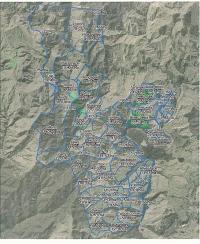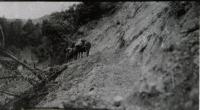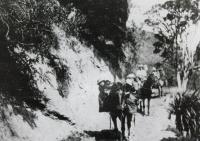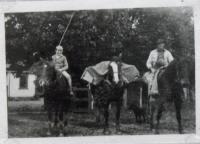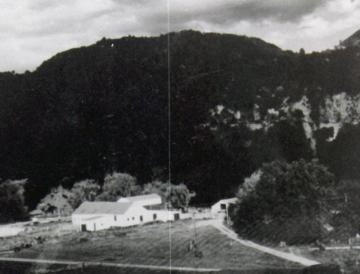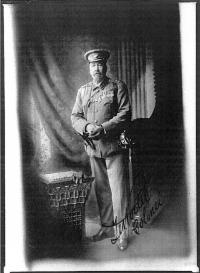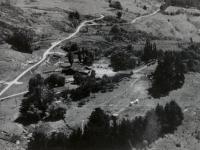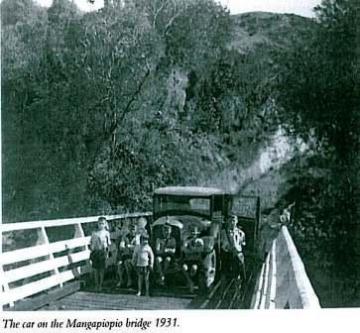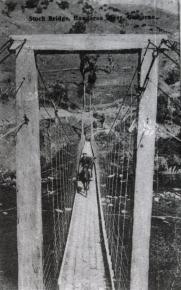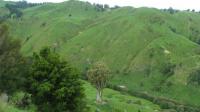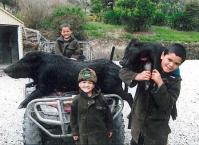Home-Tiniroto through the looking glass
- Team Tiniroto
- Research process
- Learning outcomes
- Moa at Tiniroto
- Legend of Whakapunake
- The legend of our rivers
- Te Kooti in Tiniroto
- Farming history in Tiniroto
- Schools in Tiniroto
- The history of the Tiniroto Tavern
- The Army in Tiniroto
- Communication over the years
- Ruakaka Station
- Earthquakes in Tiniroto District
- Fighting fires
- Community Hall
- Te Roto
- Te Awa
- Native birds
- Our maunga
- Tiniroto landscapes
- Remembered for?
- References and acknowledgements
Ruakaka Station
Ruakaka Station is one of the many large stations in the Tiniroto District. It was made through purchasing of several smaller adjacent properties throughout the years. Many parts of the station still bear their earlier name sakes. Today the property is owned by the King whanau and is farmed as a partnership of two brothers and their families.
Roading has always played an important role in life of these outlying properties, it still does today.
Originally the road in from Tiniroto was unstable. If it had not been for the constant vigilance and attention expended on it by the old roadman, it would have been impassable more often than not. The little old man who was stone deaf, would leave his house early in the morning carrying his shovel over his shoulder as he rode his horse to work followed by his little fox terrier. He would leave his horse loose to graze while he worked on the road, his dog would take guard on the outside verge of the road.
When a vehicle appeared the dog would quickly run and stand at the road works to let Phil know to move back out of the way. Prior to this the locals had to sledge loads of boulders from the river to the worst parts of the road themselves and pack them into the wheel tracks so the road could be used for most of the year.
For a few years Bruce and Betty Spence kept their car in one of Author Richard’s sons shed (now Jackmans) over the winter months.
The stores for the farms were brought in twice a year towards the end of autumn and late spring, and everything was purchased in bulk. As in all the stations in the area, cows were milked and butter made, large vegetable gardens were kept and meat was killed for eating at the stations.
1898 Thomas Bruce Spence in partnership with John Leslie Spence bought some land out the back of the Tiniroto district.
Spence built a Punga hut for his wife Mabel and their children on the Tiniroto side of the river just below the present Quinn’s bridge.
Spence had to cross the river each day to begin clearing the land. He fenced it by stacking logs around the area to be grazed. When their first daughter was born the family purchased a calf which they fed on mixture of half flour and water mixture, on which the calf thrived. The family lived on wild pigs, pigeons and when time allowed John rode up to Abbotsford and bought a mutton to carry home.
In the early 1900’s white pine was felled to build the house across the river.
Syd Kent told me that “Ruakaka was the main station, 6000 acres including the Mangaroa block. There were big gangs of men breaking in the land by bush felling. Mr Kent’s father was a shepherd on Ruakaka. One of his jobs was to pack the meat out to the bushmen. At the station there were 5/6 shepherds and they used to run short on tucker. My dad used to deliver the supplies to the bushmen who were clearing the land, on the way he would slip some of the supplies out and into his pikau and then take it back to the cookhouse to make sure they had plenty of meat. Then he got caught and that was the end of that lark.”
1912 Captain Porter bought 1200 acres down the river from the Ruakaka homestead as did Mr. Welliourne and Mr Boyes.
They had access across the river by way of a swing bridge from the now Reserve to the paddock now known as Black Jacks. These two blocks were sold to the Spence brothers in mid 1920’s.
“Much later when JL (Mr J L Spence), used to own Ruakaka they would be out draughting sheep on a hot sunny day and all the dust would be coming up into the house. Everyday about 10 oclock, Mrs J L would come out on to the veranda, and call out “Mr J L Telephone! Telephone!” He would hurry inside and have a rest, cup of tea… the shepherds all knew what was going on and were not impressed!”
In 1928 the Spence partnership was dissolved and John taking the Mangaroa block which had access from the Ruakituri and Thomas employed Tom Fahy to manage the Ruakaka block. Interestingly in recent years the current owners of Ruakaka also owned Mangaroa station as part of a family partnership.
Mr Kent remembers about the significance of the Ruakaka wool storage shed build at Tiniroto.
“It was built in about 1921, after the big fall in the price of wool. Ruakaka bought it out and stacked it up in the shed, when prices improved they sold it. When it wasn’t used as a shed for wool, they then had a couple of dances, as time went by it started to be referred to as the Tiniroto Hall. In those days of course it had no lining; it was really just the shed. Over the years it was more for dancing in, as a stage for plays and the children from school went up to it. There was no power; lighting was provided by carbide (bit like gas lighting). While we were dancing, one of us ‘hard cases’, would slip out the back to the shed and turn off the carbite, so there would be no light, then slip back in to dance with your girl in the dark! The old fellows would try to keep an eye on the young guys. In those days there used to be the Baty family of three brothers, one played piano, one played saxophone, and I think a guitar – they played the music. The dancing was waltzing.”
Son Bruce Spence came back as a Shepherd on Ruakaka along with Trever Coleman. In 1930 by the arrangement of the two stations namely Ruakaka, Awapiko and the county, a bridge was built over the Mangapoipoi stream.
Tom Fahy brought land in 1932, now known as the Fahy Block and now owned by the Law family.
Geoff Spence then took over as manager of Ruakaka and continued until the commencement of World War Two when he enlisted and Bruce Spence then became the manager.
Pynson Mossman built a shed beside the loading ramp at Ruakaka to store the car and their saddles in. “It would have taken an hour and a half to ride to Ruakaka from Tiniroto. Straight across the hill and river, there was a place called the BATH, because it was really slippery on the Papa and there was a big pool. Quite a few travellers had a bath; horse and all!”
The old swing bridge to Porters was used for access until the early 1940’s when it was swept away by a big flood and has never been replaced.
One by one all the shepherds from Ruakaka and the surrounding stations went off to the war and Bruce with the help of his younger brother Marshall worked the station with the help of World War One veteran Vick Watt, an expert blacksmith.
To overcome the labour shortage at this time the people in the district pooled their labour and helped each other out.
The Richardson brothers were others to work at Ruakaka. Other people to help out in the area were the local Maori population who worked as fencers, general hands and shearers. Willie Marsh and his brother Koko were two of these people.
In 1969, Ruakaka consisting of 6422 acres was sold to the Lyons brothers from Hawkes Bay except for a block of 1088 acres now known as Rongoio, which was held by Bruce Spence for four years before it was passed onto his son Ray Spence.
Bill Lyons came and lived at Ruakaka until the mid 1970’s when he employed John Honey as the manager and went back with his wife Hillary and their four sons to Hawkes Bay to live.
In 1987 John Honey left Ruakaka and Martyn Hayes took over management, having been a shepherd previously on the property.
In February 1992 Ruakaka again changed hands having been brought by Bruce and Piri Hall, who sold the property in 1996.
In 2005 Mangaroa Ltd leased the property from Kingdom Holdings (an overseas entity) at the time they owned Mangaroa station returning the property to its 1928 arrangement! Recently the two King brothers purchased Ruakaka in 2008, their 3 sons Levi, Haeora and Erueti are current pupils at the Tiniroto School.
It now takes about 20 minutes from Tiniroto to the homestead. The whole family are very keen hunters and rugby players. They are active community members being involved in the local Game Hunting Association and Pania is the Chairperson of the Tiniroto BOT, brother in law Ronald King is the Chairperson of the Community Association.
By Levi

